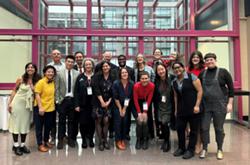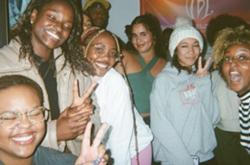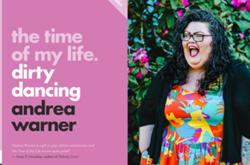
On Saturday, the CanWest youth magazine Dose will celebrate 365 days of existence with a birthday party at the Plaza of Nations and other locations across the country. Its inception last spring made me tingle with excitement like a veritable media nerd. Fresh out of the bloated bubble of my undergraduate education, I was thirsty for news that might manage to target my own demographic: young, hip and most importantly, informed.
Alas, I held on for a week before giving up altogether. Then spent the rest of my summer wiping sunscreen off my hands onto its cartoonish pages.
I need more than bright and shiny
Dose is flashy and visually elaborate -- and offers me nothing of substance. As someone not that far removed from my childhood, the frantic colour coding of Dose's pages began to remind me of my early colouring books, only not nearly as soothing. And no, Dose certainly doesn't colour outside the lines. Like many other sources of traditional media, CanWest was clearly wringing their hands about low newspaper sales in the 18-34 year old demographic. But I don't think this publication is going to raise those numbers.
While it promises a buffet of news, entertainment and opinion all in a youth-savvy package, in the end, it delivers microscopic stories short on information. If I want good gossip, I pick up a People magazine. If I want hard news, I grab a nice, thick issue of the Globe and Mail, or visit one of my many bookmarked online sites such as CBC.ca, Guardian, Salon, or BBC.
What corporations like CanWest who try to "sell" news to youth don't understand is this: it's not that we can't handle the "weight" of a traditional daily newspaper, it's that we actually want more.
Show me content, not beer
The "more" we want isn't advertorial or product placement. In fact, a study released by Dr. Claire Boily from the Observatoire Jeunes et Societe about youth and the media shows that one of the reasons young people are turning away from traditional news sources is that they distrust the corporate influence and the "bias" that brings.
That makes it difficult because apparently, "free" media is important to youth. We've grown up getting our information free of charge on the Internet, from official media sites and also blogs, so we're not rushing to buy subscriptions to newspapers. This means, in most cases, the money has to come from advertising.
"We sometimes run ads on our cover, which makes me squirm," explains Pema Hegan, Dose's editor-in-chief, who spoke to the presence of a Kokanee ad that filled his magazine's entire front page. He was speaking to a "Youth and the News" conference put on by the Canadian Media Research Consortium in Vancouver on Monday. "But we just explain it to people and tell people what's going on. We say running ads like this pays for content in the paper and on the website, and keeps it free," he said.
Hegan went on to explain that in a recent feature on addiction, Dose solicited product placement of Nintendo's Tetris, which Nintendo paid for. They included Tetris within the feature's editorial content. Hegan said the reason they did this is that "a brand can contain more information than words. Just incorporating the Tetris brand says more to youth about the concept of addiction than anything else. Not everyone agrees with me, but sometimes product placement is appropriate and sometimes it's not. And that line is moving constantly."
If I have to stare at a giant, sweating bottle of Kokanee on the front of my newspaper, instead of editorially-related art, or have to work to separate the ads from the news as I read, I don't see why I should bother. I'll stick to free Internet sites I can trust, instead; where ads aren't popping up and getting in the way.
And I'm not alone. Since youth already express general distrust of corporate media sources, if those at the helm won't make a firm distinction between editorial content and a marketing takeover, youth will continue to take their business elsewhere.
Youth? What is that anyway?
Another thing driving many young people away is this concept of the market researched, homogeneous youth that many publications target. And many of these images of youth seem a little "off."
Whether it be the evolution of the "grup" (hipsters over 35 who still dress in vintage jeans and pricey sneakers, but have kids and steady incomes) that is convincing editors at large that childishness is permanent or be it staggering misconceptions of youth culture, something is very wrong with the way Dose is communicating to youth. It's vacant.
Though I know few youth who turn to publications for a definition of their identity, I'm disturbed by what I see reflected in the pages of Dose. This seems to be their target audience: "I'm a youth who can't handle a sizeable and continuous stream of print content. I'm fickle. I'm petty. And no one understands me. All I do is buy, buy, buy. And if I don't get that iPod for Christmas, I'm going to be über pissed."
If that's what I am, I'm my worst nightmare. I'm a teenager.
A kid at 35
It doesn't surprise me then, that Dose-advertised products seem targeted to appeal to high schoolers. Except, much to my surprise, the term "youth," in demographic marketing speak, no longer even seems to refer to adolescents or teenagers. Some say the age group centers around 18 to 30-year-olds, while others argue it could even be extended to the age of 35.
At least that 35-year-old can drink the beer from the Kokanee ad Dose plastered across its front page.
If Hegan and I were to sit down and compare notes about what youth want, I think we'd be butting heads. He admitted during his presentation "the young people [they] researched, they don't take anything too seriously."
My friends and acquaintances, who are mostly between the ages of 18 and 30, admit to picking up Dose because it is there and it is free, but say they are never completely satisfied.
Try some trust
"[Media sources] should not assume we are less educated, if they want to gain our trust" said Steve D'Alimonte, a 24-year-old who regularly reads the Toronto version of Dose.
D'Alimonte said he enjoys what he considers the "youthful" or "alternative" aspects of the magazine, like their recent coverage of the Junos, but that he'll often turn to a different source for other in-depth coverage.
"If I want to read international news, I'll read CNN or the [Toronto] Star," he said. "If I can't read those, I'll read Dose and I'll take it with a grain of salt."
In general, D'Alimonte said he thinks traditional media sources are accessible to some people, but publications often aren't taking the important step to make themselves more accessible to young people.
"Youth who are educated want to read these things," he said. "Others won't seek it out."
After some deep thought, I'd have to say that youth are budding tradespeople, doctors, politicians, mechanics, parents, musicians, writers and active citizens; everything that "adults" are. We aren't the future -- we're the now. We aren't so enamoured by blogging that we'll ignore our desires for credibility and integrity. While we might enjoy an exposé on J-Lo's posterior size, we also read in-depth features online and in print. Like adults, we enjoy a diverse range of topics, content and styles.
Give me some credit
"It's embarrassing when you think that you're writing for such smart people," Hegan said on Monday.
As if there's a stronger indicator of a need for a boost in youth media and expression. If we're so smart, our publications should be a reflection of our intelligence and not mere pandering to the market-researched misinterpretation of vapid youth.
Allison Cross is on staff at The Tyee.














Tyee Commenting Guidelines
Comments that violate guidelines risk being deleted, and violations may result in a temporary or permanent user ban. Maintain the spirit of good conversation to stay in the discussion.
*Please note The Tyee is not a forum for spreading misinformation about COVID-19, denying its existence or minimizing its risk to public health.
Do:
Do not: